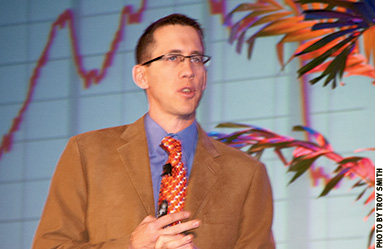Tight Supplies, High Prices
Affecting Beef Outlook
Global opportunities exist for beef, but continued contraction in the United States is expected.
by Kindra Gordon for Angus Journal
TAMPA, Fla. (Feb. 8, 2013) — Randy Blach, CEO of CattleFax, said the market environment for the industry had been a “rocky road for everyone” during the last 12 months as he addressed Cattle Industry Convention attendees in Tampa, Fla., Feb. 8. Said Blach, “Even though we had record cattle prices, it was difficult for anyone to make any money because we had high hay (feed) prices, too."
Unfortunately, the outlook for 2013 may likely be much of the same.
“I would say be careful as you look at the marketplace. We’re going to have record-high cattle prices, but it may be difficult to make any money," Blach predicted, because also record-high breakevens.
He added, “Manage your risk to avoid equity loss until we get through this period and rain comes.”
Domestic beef demand also has a dismal outlook. CattleFax analyst Mike Murphy reported that no significant growth in the nation’s gross domestic product (GDP) is expected for 2013. “It will stay positive but only grow at 1%-2% and that is some concern for beef demand in 2013,” Murphy told convention attendees.
Murphy attributed this to the fact that a lot of the country is still unemployed and carrying a heavy debt load. The $4-per-gallon gas price is also a factor dragging on beef demand.

CattleFax analyst Mike Murphy reported that no significant growth in the nation’s gross domestic product (GDP) is expected for 2013.
“More disposable income going to fuel means less money to spend on other items such as beef,” said Murphy.
He noted that high gas prices offer another lesson for the beef industry as well. Murphy pointed out that as gas prices have increased, consumers have decreased their travel and use of fuel. With retail beef prices steadily increasing, Murphy said, “This is something the beef industry must watch as well” — hinting that beef demand and consumption could taper off domestically.
Murphy said the bright spot in the 2013 picture is the fact that the GDP in emerging and developing countries like Vietnam and China will grow, which could help boost meat exports to those countries.
Murphy said the recent announcement allowing expanded beef access to Japan is also a “big deal.” He noted this will be positive for beef exports in general, but explained that the real positive will come on the variety meats. “That’s where we’ll be able to add a lot of value to the bottom line.
Regarding Russia’s ban on U.S. beef, Murphy said, “We don’t see a quick resolution to that situation.”
Given the tight beef supplies in the United States, Murphy explained that beef imports will likely be up 12%-15% from a year ago, as well.
Addressing the supply situation and looking at rebuilding of the U.S. cow herd, CattleFax’s Kevin Good noted that fewer cows are being slaughtered, and said, “Don’t be surprised over the next couple years if less heifers are going into feedlots as more are being used for replacements.”
He acknowledged much depends on Mother Nature.
“The economic incentive is there to expand,” Good said, “and we do expect to see that as soon as Mother Nature cooperates.”
For the first quarter of 2013 Good said the cattle are there to be placed into feedlots, which would create a larger beef supply for summer. Despite that, CattleFax estimates anticipate retail beef prices will be up 4% in 2013, which could hinder beef purchasing by consumers.
In closing, Blach encouraged the U.S. cattle sector to look at the bigger picture for the next five to 10 years. He noted that the trend for global consumption of protein offers great opportunity for the United States.
Only 4% of the world’s population lives in the United States, he emphasized. “Having access to these [export] markets is key to the future of the U.S. beef industry.” In 10 years, Blach projected, the potential exists to export 20% of U.S. beef product. Today, the value of beef and beef byproduct exports contribute $277 per head to the value of the animal.
However, Blach also emphasized the need to be realistic about the future, saying there will likely be more closing of beef slaughter plants and feedlots near term. He concluded, “Our industry is going to be smaller. It’s going to contract. We need to cope with that and accept that reality.”
--------------------
Editor’s Note: The above article was written under contract or by staff of the Angus Journal. It may not be reprinted without express permission of the Angus Journal. To request reprint permission, contact the editor at 816-383-5200.
www.4cattlemen.com is an event coverage site provided by the editorial team at Angus Productions Inc. (API), publisher of the Angus Journal, the Angus Beef Bulletin, the Angus Beef Bulletin EXTRA and the Angus e-List. For questions about this site, to submit an article for our consideration, or to report a broken link, contact the editor at 816-383-5200; 3201 Frederick Ave., Saint Joseph, MO 64506.
API claims copyright to this website as presented. We welcome educational venues and cattlemen to link to this site as a service to their audience.

